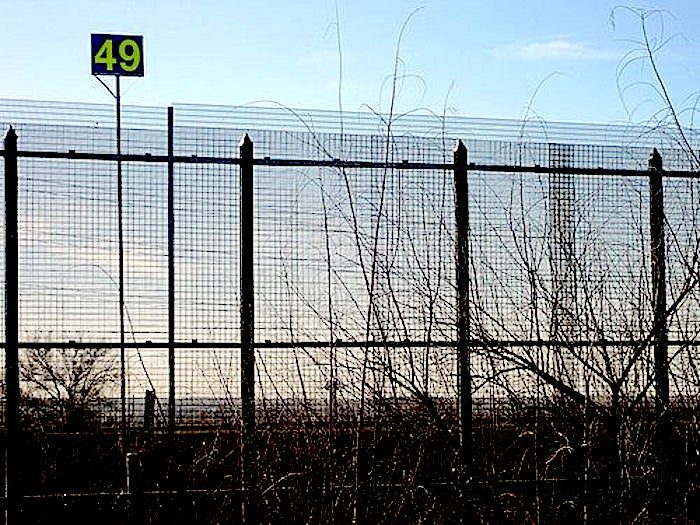
© MapQuestUS-Mexico border fence, El Paso, Texas
When charges of "racism" and "xenophobia" fail, Democrats' fallback argument against President Trump's proposed border wall is that it simply "won't work," so why waste billions building it? Tell that to the residents of El Paso, Texas.
Federal data show a far-less imposing wall than the one Trump envisions - a two-story corrugated metal fence first erected under the Bush administration - already has dramatically curtailed both illegal border crossings and crime in Texas' sixth-largest city, which borders the high-crime Mexican city of Juarez.
In fact,
the number of deportable illegal immigrants located by the US Border Patrol plummeted by more than 89 percent over the five-year period during which the controversial new fence was built, according to Homeland Security data reviewed by me. When the project first started in 2006,
illegal crossings totaled 122,261, but by 2010, when the 131-mile fence was completed from one end of El Paso out into the New Mexico desert,
immigrant crossings shrank to just 12,251.
They hit a low of 9,678 in 2012, before slowly ticking back up to a total of 25,193 last year. But they're still well below pre-fence levels, and the
Border Patrol credits the fortified barrier dividing El Paso from Mexico for the reduction in illegal flows. And crime abated with the reduced human traffic from Juarez, considered one of the most dangerous places in the world due to drug-cartel violence, helping El Paso become one of the safest large cities in America.
Before 2010, federal data show the border city was mired in violent crime and drug smuggling, thanks in large part to illicit activities spilling over from the Mexican side. Once the fence went up, however,
things changed almost overnight. El Paso since then has consistently topped rankings for cities of 500,000 residents or more with low crime rates, based on FBI-collected statistics. The turnaround even caught the attention of former Homeland Security Secretary Janet Napolitano and other Obama administration officials, who touted it as one of the nation's safest cities while citing the beefed-up border security there.
Federal data illustrates just how remarkable the turnaround in crime has been since the fence was built. According to FBI tables, property crimes in El Paso have plunged more than 37 percent to 12,357 from their pre-fence peak of 19,702 a year, while violent crimes have dropped more than 6 percent to 2,682 from a peak of 2,861 a year.
The overall crime rate in El Paso continued to fall last year, prompting city leaders to trumpet the good news in a press release that noted, "Because El Paso is a border town, its low crime rate may surprise you." El Paso City Manager Tommy Gonzalez boasted that the city will "continue to lead our country in public safety."
Another core promise made by Trump to justify constructing a massive wall spanning from Texas to California is that it will slow the flow of drugs coming across the border from Mexico."We need the wall for security. We need the wall for safety," Trump said last week while answering questions about the sweeping new GOP immigration bill. "We need the wall for stopping the drugs from pouring in." On that score, El Paso already has exceeded expectations.
Drug smuggling along that border entry point has also fallen dramatically. In fact, since the fence was completed,
the volume of marijuana and cocaine coming through El Paso and seized by Border Patrol agents has been cut in half.The year before the wall was fully built in 2010, the volume of illegal drugs confiscated by the feds along the El Paso border hit 87,725 pounds. The year after, the amount of drug seizures plummeted to 43,783 pounds. Last year, they dropped even further to a total of 34,329, according to Border Patrol reports obtained by
The Post.All told, a legion of empirical evidence supports the idea a southern border wall could, in fact, work. There is also anecdotal evidence. In local press accounts, El Paso residents and business owners alike have praised the fence, citing it as an effective deterrent to both illegal crossings and crime.
Now Trump plans to build a possibly bigger deterrent.
The existing fence along the El Paso sector, which is made of a combination of corrugated steel and metal meshing, towers 21-feet high at some points and is already hard to climb.
But the Trump wall, which will begin construction in El Paso, will be even taller and have multiple layers of security.Still, Democratic leaders are adamantly opposed to it. They argue the $18 billion wall won't work to keep out illegal immigrants and drugs, and will only be a massive waste of tax dollars. "We think, frankly, the building of the wall, its cost is not justified either by its efficiency or effectiveness," House Minority Whip Rep. Steny Hoyer (D-Md.) said Thursday.
Even local Democrats are arguing with success. "That wall in itself is a racist reaction to a racist myth that does not reflect the reality of this country at all," said Rep. Beto O'Rourke (D-El Paso).
Paul Sperry is a former Hoover Institution media fellow and author of several books, including the bestseller Infiltration
.
Comment: In El Paso, at least, there reportedly is a wall of evidence!